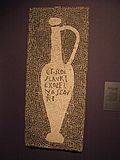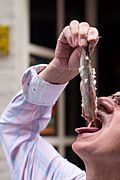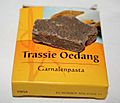Fermented fish facts for kids
Fermented fish is a traditional way to keep fish from spoiling. Long ago, before we had refrigerators or cans, fermenting was a very important method to preserve food. Fish can go bad quickly because of tiny living things called microbes or bacteria. Fermenting stops these microbes from spoiling the fish. It makes the fish muscle more acidic, which means the pH level drops. Most bacteria can't grow when the pH is below 4.5.
Today, there's a newer method called biopreservation. This involves adding special good bacteria, like lactic acid bacteria, to the fish. These good bacteria create things that fight off the bad microbes, such as lactic acid, acetic acid, and other helpful substances. They can even make a strong preservative called nisin.
Sometimes, fermented fish can have a very strong, unusual smell. Even though we have many ways to preserve fish now, people still ferment fish because they really enjoy its unique taste.
Risks of Eating Fermented Fish
In Alaska, there have been more cases of a serious illness called botulism since 1985. This illness is caused by a type of bacteria. Alaska has more cases of foodborne botulism than any other state in the United States. This often happens because of a traditional practice by the Inuit people. They used to let animal products like fish, fish heads, or parts of walrus and whale ferment for a long time before eating them.
The risk of botulism gets even higher when people use plastic containers instead of the old, traditional way. The traditional method involved a hole in the ground lined with grass. Plastic containers can seal the food very tightly, creating a space without air. The botulism bacteria love to grow in places without air, which makes the food dangerous.
How Fermented Fish is Made Around the World
| Name | Image | Where it's from | How it's made |
|---|---|---|---|
| Bagoong |  |
Philippines | This is fish or shrimp that has been partly or fully fermented. To make fish bagoong, salt is mixed with fish and put into large clay jars. It ferments for 30 to 90 days, stirred sometimes to spread the salt. A red food coloring called angkak is added for its color. Some makers grind the fermented mix into a fish paste. A liquid called patis (fish sauce) is also made during this process. |
| Bottarga |  |
Mediterranean, Mauritania | Bottarga is salted and cured fish eggs, usually from grey mullet. These fish are often found near coastlines worldwide. |
| Burong isda |  |
Philippines | This Filipino dish uses cooked rice and filleted fish. It's fermented with salt and angkak (red yeast rice) for about a week. |
| Chêpa Shũṭki | Bengal, Bangladesh | This means "pressurized dried fish." Puti Fish are sun-dried for 12 to 14 days. Then they are kept in a jute sack for one month. After that, they are washed and put into a pressurized clay pot for 3 to 4 months. | |
| Colombo cure | Sri Lanka, India, Bangladesh | Fish are cleaned, washed, and salted with dried fruit pulp or tamarind. The fish are covered in salty water (brine) with weights on top. They ferment for 2 to 4 months. | |
| Fesikh |  |
Egypt, Sudan | This is fermented, salted, and dried mullet. The fish is dried in the sun, then preserved in salt. Making fesikh is a special skill passed down in families. In Egypt, people eat fesikh during the Sham el-Nessim spring festival. In Sudan, other fish types are used, and it ferments for 10 to 20 days. |
| Fish sauce |  |
Asia | This is a clear liquid made from salted and fermented anchovies or other fish. It ferments for usually six months or more, sometimes up to a year and a half. The longer it ferments, the better it tastes. It has many local names across Asia. A similar product in Italy is called colatura di Alici. |
| Funazushi |  |
Japan | Fresh funa (a freshwater fish) are cleaned, keeping the body and eggs whole. The fish are packed with salt and aged for a year. Then they are repacked yearly in rice for up to four years. This fermented dish can be sliced thin or used in other meals. |
| Garum |  |
Ancient Greece | This was a fermented fish sauce and a very important flavor in ancient times. |
| Guedj |  |
Senegal | This is salt-cured fish, popular for flavoring dishes in Senegal and West Africa. Whole or split fish are cleaned and packed with coarse sea salt. They ferment for one to three days, then are sun-dried. |
| Hákarl |  |
Iceland | This is Greenland shark or basking shark that is cured and hung to dry for four to five months. Hákarl has a strong smell like ammonia and a powerful fish and cheese taste. It's often called an "acquired taste," meaning most people need to try it a few times to like it. Traditionally, the shark is buried in sandy ground with stones on top to press out liquids. It ferments for 6–12 weeks, then is cut into strips and dried for months. |
| Hentak | Manipur | Made from powdered, sun-dried Indian flying barb fish and the stems (petioles) of aroid plants. | |
| Hongeohoe |  |
Korea | This dish is made from fermented skate fish. It has a very strong smell, like ammonia. It is usually served raw with other Korean side dishes like kimchi. |
| Jeotgal |  |
Korea | These are salted and fermented dishes made from seafood like fish, shellfish, and other sea animals. Depending on what's used, jeotgal can be solid pieces or a clear, broth-like liquid. Solid jeotgal is often eaten as a side dish. The liquid kind, called aekjeot, is popular for seasoning kimchi and in soups. |
| Kusaya |  |
Japan | This is salted, dried, and fermented fish, known for its very strong smell, similar to the Swedish surströmming. Even though it smells strong, the taste is quite mild. It's often eaten with Japanese sake or shōchū. Kusaya comes from the Izu Islands. Long ago, people used salt many times to cure fish because salt was expensive. This made the fish very pungent, and it became known as kusaya. The special, smelly liquid used for fermentation has been passed down in families for generations. |
| Lakerda | Greece | Bonito fish steaks are deboned, soaked in salty water (brine), then salted and weighted for about a week. They can be eaten right away or stored in olive oil. Sometimes, large mackerel or small tuna are used instead of bonito. | |
| Lanhouin | Ghana, Togo, Benin | Lanhouin is salted, fermented, and dried fish made in the coastal areas of the Gulf of Benin. It uses fish like croaker or West African Spanish mackerel. Lanhouin is widely used as a seasoning. | |
| Mahyaveh | Iran | Mahyaveh is made in southern Iran from sardines or anchovies, salt, spices, and water. The fish are cleaned, mixed with salt and warm water, and packed into jars. After a month, the mix is mashed and filtered. The brown liquid is then mixed with mustard and other spices like cumin and black pepper. After another 10 to 15 days, the sauce is ready. | |
| Matjes (maatjes) herring |  |
Netherlands, Germany | This is lightly salted and fermented young herring. It's usually eaten with chopped onion. The name comes from the Dutch word for "virgin," because the young herring haven't developed their eggs yet. |
| Momone (momoni) | Ghana | Momone is made in Ghana from different kinds of fish, squid, and octopus. The fish is cleaned, rubbed with salt, and packed in layers in barrels with more salt. After fermenting for 7 days, the fish are dried in the sun. Pieces of momone are often boiled into a sauce with red pepper, tomato, onion, and palm oil. | |
| Ngari | Manipur India |
Ngari is a traditional fermented food from Manipur. It's made by fermenting small freshwater fish with mustard oil and salt. The dried fish are packed tightly into a large clay pot, which is sealed to keep air out. The pot is then buried for 30–40 days. Ngari is lightly roasted before eating and added to many Manipuri dishes. | |
| Pekasam | Malaysia | This is fermented, partly or fully fried rice mixed with various freshwater fish. The fish is cleaned, cut, and preserved with salt for several days. Then it's mixed with partly fried Rice bran and palm sugar or brown sugar. The sugar helps the rice bran ferment. Sometimes tamarind juice is added to make it more sour. It's traditionally left in a clay pot to ferment for at least a week, or up to a year. | |
| Prahok |  |
Cambodia | Prahok is a crushed, salted, and fermented fish paste, usually made from mud fish. It's used in Cambodian cooking as a seasoning or condiment. It started as a way to preserve fish when fresh fish wasn't plentiful. Because it's salty and has a strong flavor, it's added to many Cambodian meals, like soups. Prahok has a very strong and unique smell, earning it the nickname "Cambodian Cheese." In the countryside, people often eat prahok with rice. |
| Pla ra |  |
Thailand | This is a fermented fish sauce made by pickling different kinds of fish, mainly snakehead murrel. The fish is cleaned, cut into pieces, and mixed with salt and rice bran. It's then left in a large jar with a wooden lid to ferment for three months to a year. A dried, powdered version of pla ra is now also sold. |
| Rakfisk |  |
Norway | This is made from trout or sometimes char. The fish is salted and fermented for two to three months, or even up to a year. It's then eaten without cooking. The first mention of rakfisk was in 1348, but the food is probably much older. It's similar to the Swedish surströmming. People traditionally eat it around Christmas. |
| Sikhae |  |
Korea | This is salted and fermented food made with fish and grains. Common fish include righteye flounders, Alaska pollock, and chub mackerel. The grains are usually rice or foxtail millet. Sikhae is made in the eastern coastal regions of Korea. |
| Surströmming |  |
Sweden | This is fermented Baltic herring, famous for its very strong smell. |
| Tepa | Yup'ik | Tepas, also called stinkheads, are fermented whitefish heads. A common way to make them is to put fish heads and guts in a wooden barrel, cover it, and bury it in the ground for about a week. For a while, plastic bags and buckets were used, but this increased the risk of botulism. So, the Yupik Inuit people have gone back to fermenting fish heads directly in the ground. | |
| Tungtap | Meghalaya, India | Sun-dried, salted, and fermented Indian flying barb fish. | |
| Trassi (Indonesia) Belacan (Malaysia) |  |
Indonesia, Malaysia | These are dark blocks made from dried, fermented, and salted paste. They are made from tiny shrimp (trassi udang) or small fish (trassi ikan). |

